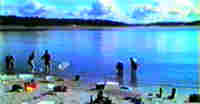|

They
are wonderful
|
|
Wandering sand bars are usually built
up of somewhat heavier sand grains that are carried inward. The weaker
outgoing currents usually carry the finer and lighter particles out to
sea. The longer waves that flow into the shallows break into surf with
wave peaks that slowly diminish in height. Under the surf, sand bars form,
and with their steep sides, wander in towards the shore. At
low tide it is possible to wander on these sand bars.
Swell zone
The waves end their journey in the swell
zone and when they arrive on the beach their movement is irregular. Larger
and rounder material is deposited in the deeper areas of the swell zone,
while smaller and flater particles are deposited in the shallower end
of the swell zone. The larger the deposited material is, the steeper the
beach. If a beach is composed of large material and only small waves,
the wave energy will be too little to level out the beach and create shoals.
These beaches often lack a shallow surf zone. Organisms on this type of
beach have a difficult time because of the large material that has been
deposited, and because the waves usually have their full force, as they
have not been slowed down before reaching the swell zone.
Difficult to swim against the current
Powerful waves press in a lot of water
onto the shore. This water often runs in a depression between the beach
and bar, until it finds a narrow opening in the bar where it runs out
with increased speed, a rip current. While swimming, it is possible to
get caught in such currents and be swept out to sea. In Swedish waters
there is little risk of such an occurrence because the large oceanic waves
do not reach the Swedish coast, but if abroad and caught in such a current,
it is easy to find calmer water because these currents are usually rather
narrow. By swimming parallel with the beach you will soon leave the strong
current.
|

|
Page 3
of 15
|

|
|